Apr 2008
D-FW's last true anchor/reporter (not necessarily in that order)
16/04/08 10:25
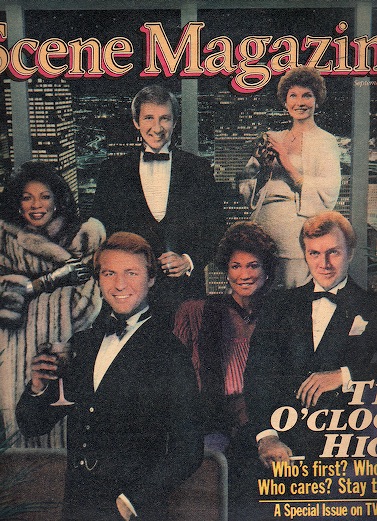
Note to readers: D-FW's featured 6 and 10 p.m. weekday news anchors mostly do just that -- anchor. They're rarely seen "in the field," unless it's at a speaking engagement or the Texas State Fair. We have to rewind more than a quarter-century to find the market's last bonafide day-to-day anchor/reporter. Dave Layman paid a price for that, lasting less than two years at KXAS-TV (Channel 5) long before it was bought by NBC. This story, originally published on May 20, 1982 and headlined "Dave Layman believes he's a reporter first," documents how and why he didn't survive long-term with co-anchor and former Miss America Jane Jayroe.
By ED BARK
Dave Layman, Channel 5's newly deposed news anchor, has his heart in the right place, all right.
But he also wears one on his sleeve, and this tends to diminish his stature on the air. Layman often comes off as a middleweight competing against the polished performances of his competitors, Channel 4's Chip Moody and Channel 8's Tracy Rowlett.
With Layman, "there was just something missing," said Channel 5 news director Bill Vance. "Boy, I wish the heck I could define it."
Layman was told to look for other work Wednesday after 20 months of teaming with Jane Jayroe on Channel 5's 6 and 10 p.m. weekday newscasts. He'll remain on the air for a while, until station management finds a "suitable replacement."
Channel 5 staffers got the word about Layman in a memorandum posted by management. Layman then distributed his own memo, in which he said thanks for the memories and keep up the good work.
"I thought it was a pretty classy thing to do," a Channel 5 reporter said of Layman's note. "I think a lot of people feel bad about his going, because you won't find anybody who cares more than Dave or who tries harder."
Too hard, it often seemed when watching him anchor newscasts. Layman oozed enthusiasm, but frequently lacked presence.
"Sometimes he got hung up in the field too long and ended up pushing himself against the clock," Vance said. "Then he wouldn't have time to go over his script adequately."
Layman, 37, is as earnest as they come and a prototype workaholic. As a boy he had a severe stuttering problem that he overcame on his own. Maybe that has something to do with his relentless determination to do it all at Channel 5: anchor, reporter and host of the Layman & Co. public affairs show, too. Not in that order, though.
"It was reporting, Layman & Co. and then anchoring," a Channel 5 staffer said. "Anchoring came last for him -- and that was part of the problem."
Layman still thinks he has the solution.
"There's no reason in the world," he said, "why an anchor can't get out there on the street. I don't think what happened to me is any kind of indictment that says you can't be both a reporter and an anchor. I'll be disappointed if Channel 5 changes its policy on that, but they may want somebody who wasn't quite as eager as I was about it."
Layman said his plans are to go on to an even larger television market (Dallas-Fort Worth is the 10th largest) and be an anchor/reporter again.
"You absolutely can do both," he maintained, "and the challenge is to do both of them well. The problem is that most anchors don't want to be bothered with reporting. And I think that's a mistake. I'm going to take this situation and turn it into another positive one. I'm not crazy enough to say 'New York, here I come.' But I'm proud of what I did here. These have been the two best years of my professional life."
A veteran Channel 5 staffer thinks Layman eventually will have to realize what seems to be the error of his ways.
"I don't think there's any way in hell he can do both -- unless he goes to a smaller market," the staffer said.
Vance said a good anchor by nature also should be a good reporter. But he left little doubt that Layman's replacement will be more of a news reader.
"I would like to have someone who has the reporting capability," Vance said. "But the number one function of the job is to anchor, so that's going to be the number one prerequisite."
The anchor-reporter is a dinosaur in large television markets. To maintain an illusion of sorts, most big-time anchors are expected to dabble in reporting on occasion. It looks especially nice during ratings "sweeps" periods if the anchors put on a command performance in the field. Some of these anchors in fact can report and did it for years before going behind a desk. Others never cared much for the idea of getting sweaty and mussed up "on the street." Layman wore his sweat like a badge of honor.
Knowing he wouldn't change, Channel 5 management tried to make the best of Layman's doggedness by portraying him as a whirlwind reporter in touch with the community. Seldom does hype hit the truth on the head. In his case, whammo.
Last summer, Layman was interviewed at length as part of an up-close look at this market's six major TV news anchors. Layman was late for the interview because he had been out on a story. He arrived in a sweat and had to force himself to sit down. And then the arms waved every which way while the words spilled out like a running faucet.
"Maybe sometimes I try to take on too much," he conceded. "But the more you push yourself, it seems, the better you do. I feel so strongly about going out there and reporting that sometimes I come back and my anchoring does suffer for it. There are some nights I leave here wanting to go out and slash my own tires because I tried so hard that day and left a lot of people with a bad feeling about the show. I stumbled through a few pieces of news copy and wasn't prepared. You end up giving 150 percent and you still feel like . . . It's not fair."
To the average viewer, Layman wasn't cutting it as an anchor. At least that's what Channel 5's latest research report said. Like almost every television station in a major market, Channel 5 retains a consulting firm to advise management on how to program the news. The consultant at Channel 5 is Frank N. Magid Associates, headed by one of the founding fathers of "happy talk." Based in Cedar Rapids, Iowa, Magid has been in the news consulting business for 12 years. Lots of anchors have come and gone at his firm's request.
"The research in essence confirmed what we were seeing ourselves. There was just something missing," Vance said.
Vance and Layman go back to the days when the latter was a reporter doing "cut-ins" for local segments of NBC's Today. Vance was Layman's boss at TV stations in Providence, R.I. and Columbus, Ohio. The third time in Dallas-Fort Worth wasn't a charm.
"In a sense, I discovered Dave Layman," Vance said. "So it was an especially difficult decision for me to tell him things weren't working out."
Layman was teamed with Jayroe in July, 1980. He replaced Moody, who left Channel 5 after almost 10 years to join Channel 4.
Arbitron and Nielsen numbers for the latest ratings period, the February 1982 "sweeps," put Channel 5 last at both 6 and 10 p.m. The average rating for Channel 5 has dropped slightly from 12.75 in October 1980 (the first measurement of the new team's drawing power) to the present 12.5.
No improvement in the ratings and no vote of confidence from the consulting firm meant Layman's number was up.
"If I don't write stories or report for a newscast, I'm a crummy anchor," Layman once said. "I feel like I'm a parrot, an idiot. You can't call me anything worse than a 'news reader.' To me it's the worst thing in the world, because it means an anchor didn't do anything for the newscast except just show up."
Layman did far more than just show up. And that's more or less why he'll be moving on -- again.
Nice guy finishes first -- no Harmon that
07/04/08 08:28
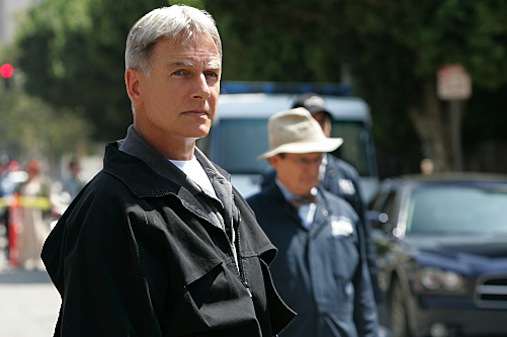
Note to readers: The old folks at home love NCIS, which returns Tuesday with new post-strike episodes on CBS. Its audience mostly "skews older," which isn't yet a capital crime. And its 56-year-old star, former UCLA quarterback Mark Harmon, has gone gracefully gray rather than succumb to a laughable Bob Costas-esque dye job. This up-close look at one of network TV's most enduring leading men was first published on Aug. 10, 2003, the summer before the then titled Navy NCIS, joined CBS' fall lineup.
By ED BARK
HOLLYWOOD -- Seemingly everyone speaks well of Mark Harmon. CBS chairman Leslie Moonves speaks effusively.
"He is truly the all-American boy, not only on-camera but off-camera," Moonves says. "He's really one of the last true gentlemen, a guy that America would like to have as their brother or their father. He's the real deal. He's the guy to be in the foxhole with."
Sturdy, trustworthy, enduring and once named People magazine's "Sexiest Man Alive," the resilient Harmon is returning to series TV this fall as the star of CBS' Navy NCIS.
Moonves has known Harmon since their days as struggling actors in the late 1970s. He's not known for dispensing sugar-coated compliments to just anyone who happens to be working for CBS. His affection for Harmon -- "as good a guy as you'll ever meet" -- is unmistakably deep-seated and genuine. More proof of that is a long-ago personal experience with the former star UCLA quarterback.
Harmon visited The Dallas Morning News in 1985 in connection with his high-visibility commercials for Coors beer. He also was co-starring in NBC's St. Elsewhere as ill-fated Dr. Robert Caldwell. After an interview, Harmon went downstairs to the paper's photo studio. A dozen or so women staffers likewise made the trip in hopes of getting a picture taken with him. One by one he complied, smiling agreeably all the while. If you think that's commonplace, it's not. Another NBC star of that period, Bruce Weitz of Hill Street Blues, couldn't have been much surlier under the same circumstances.
"Being nice is important, Harmon, 51, says in a recent interview. "Perspective is important. You work a long time to get to a position where people are chasing you around rooms. So complaining about it doesn't make sense."
The redundantly titled Navy NCIS (Navy Naval Criminal Investigative Service) is a JAG spinoff that will inherit its 7 p.m. Tuesday slot while the incumbent series moves to Fridays. Harmon plays gruff special agent Leroy Jethro Gibbs, introduced late last season in a two-part JAG story. It's his eighth go-around as a TV series regular. He also had a memorable recurring role, as Secret Service Agent Simon Donovan, in the final four episodes of The West Wing's 2001-02 season.
"I try to have a 'no jerks' clause in my contract," Harmon says. "I've gotten to the point where I'm interested in working with good people, talented people, nice people. Early on as an actor you're just trying to work. You don't have much of a choice in what you play. You're just trying to get jobs."
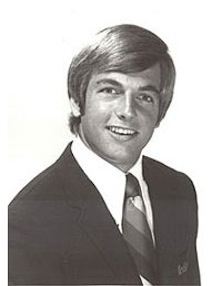

Harmon's first big job was quarterbacking the UCLA Bruins in the 1972 and 1973 seasons. It's in the genes. His father, Tom Harmon, won the Heisman trophy as a University of Michigan running back.
"People sometimes make the assumption that was a big man on campus and spent a lot of time going to sorority parties," he says. "The truth is, I don't remember having a date after a game even once in two years."
He tried to get into an acting class during his senior year, but fell short with a reading from Edgar Allan Poe's The Tell-Tale Heart.
Rebuffed, he took private acting lessons that put him on the pathway to his future profession. But he spent his early years out of college as an advertising executive and a national salesman for a tennis shoe company. Good pay, bad fits. So he quit cold turkey and phoned famed producer/actor Jack Webb (Dragnet), whom he had met while speaking on the "rubber chicken circuit" as a famed UCLA alumnus. Webb told him to shave his mustache, cut his longish hair and "look like a cop." The payoff was a bit part on a 1975 episode of Webb's long-running Adam 12 series.
Ozzie Nelson was another early mentor. Harmon's sister, Kris, was married to Nelson's heartthrob son, Rick. Toward the end of his senior year at UCLA, Ozzie asked Mark if he'd replace an ill actor in the syndicated comedy series Ozzie's Girls. He played a character named Harry "King" Kong, who showed up at the end of an episode in a gorilla outfit.
"While the credits rolled, I said, 'My name's Harry 'King' Kong. Which way's the Empire State Building?" Harmon remembers. Then he removed his gorilla head and smiled.
"It was my first acting role," he says. "For a lot of years if you needed somebody to take their shirt off and kiss the pretty girl, that was me. Or if you needed someone to say, 'Ma'am, can I see your license?' that was me."
In 1977 he landed another seemingly inconsequential part as a Jeep driver in the ABC movie Eleanor and Franklin: The White House Years. But the producers instead auditioned him for the part of hospitalized U.S. Marine Robert Dunlap, who had lost a leg in combat. His bedridden scene with Jane Alexander won him a best supporting actor Emmy nomination and his own TV series, Sam, a year later. Ironically, his future wife, Pam Dawber, whom he married in 1987, went on to star in My Sister Sam. Both series were shortlived.
"This business really isn't about the times when you're working," Harmon says. "It's more about the times when you're not."
One of his way-stops was the laughable 1983 TV movie Intimate Agony, which dealt with a herpes outbreak in a resort community.
"Oh my God. That was one of those things where you're trying to pay the gas bill," Harmon says. "I otherwise was working as a roofer at the time."
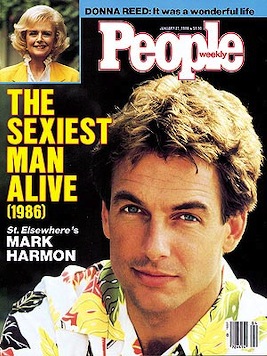
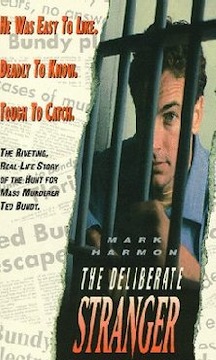
He fared far better, and turned heads, as serial killer Ted Bundy in the 1986 miniseries The Deliberate Stranger. It premiered on NBC in the same year that People named him "Sexiest Man Alive."
"His most astonishing portrayal," NBC said in print ads that showed a closeup of Harmon with a fingerprint superimposed on his face.
"I wouldn't have gotten a shot to play that role if Bundy hadn't been described in real life as the guy next door," Harmon recalls. "Otherwise it would have gone to someone who plays crazy guys. People kind of went back on their heels about it. After I did that, I was offered a lot of opportunities to play crazy guys."
His killer looks keep him in leading man roles, though. But there are still dark sides to explore. On Chicago Hope, Harmon's Dr. Jack McNeil couldn't kick his gambling addiction. And on Navy NCIS, Leroy Jethro Gibbs is a rule-bending taskmaster.
"It's all about having a well-rounded career, and it's still too early in the game to know if I've accomplished that," Harmon says. "Life doesn't read like a bio. It has steppingstones. This business is about peaks, valleys and longevity.
"You've got to keep the wheel moving. It's pretty hard to get it moving again if it ever stops."
